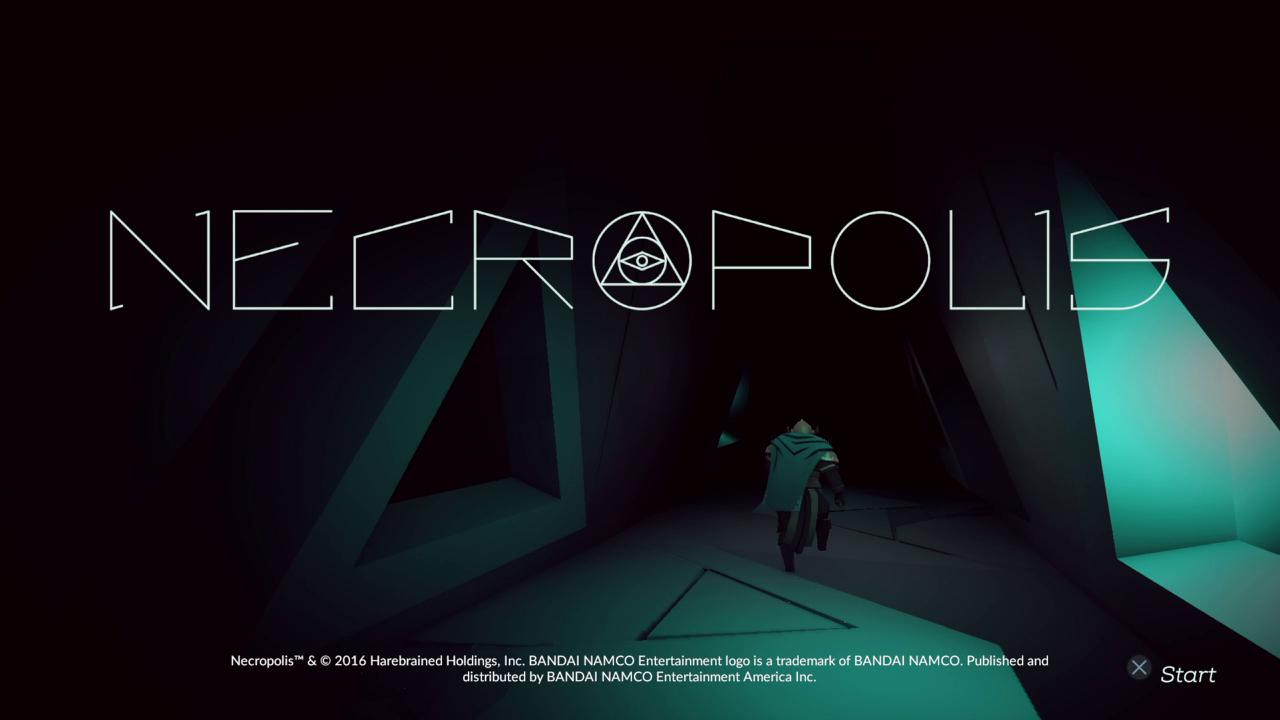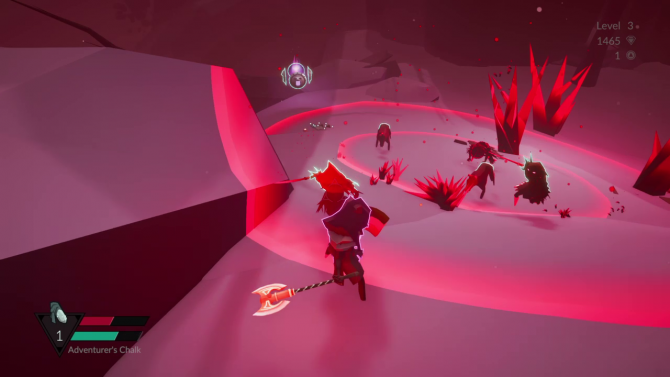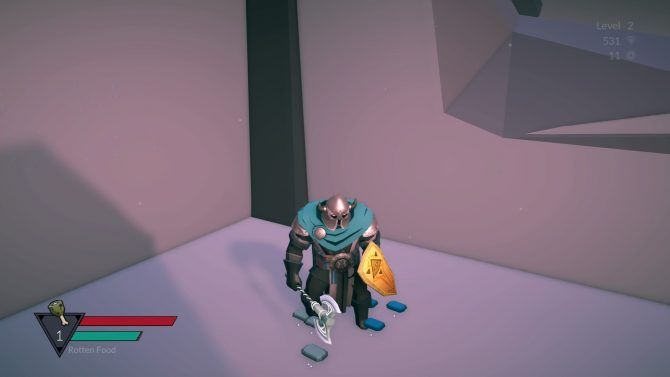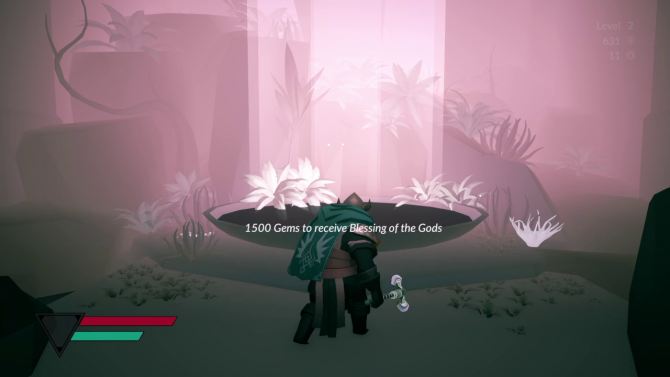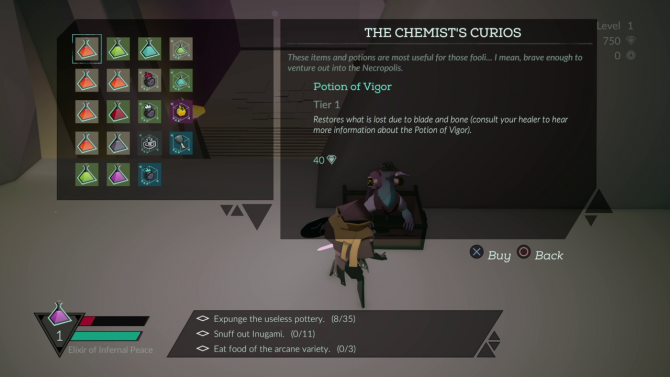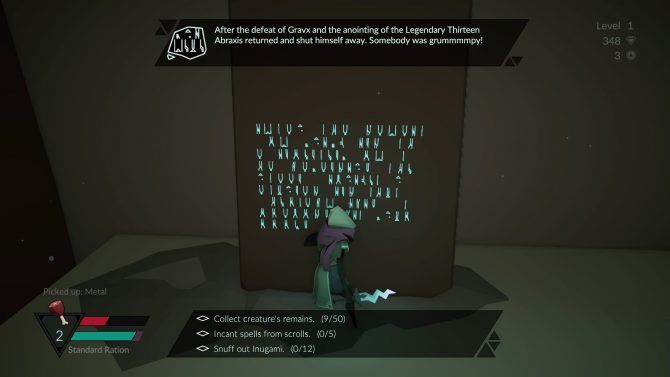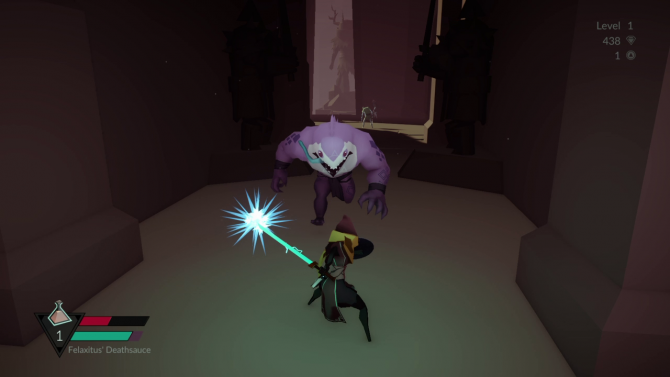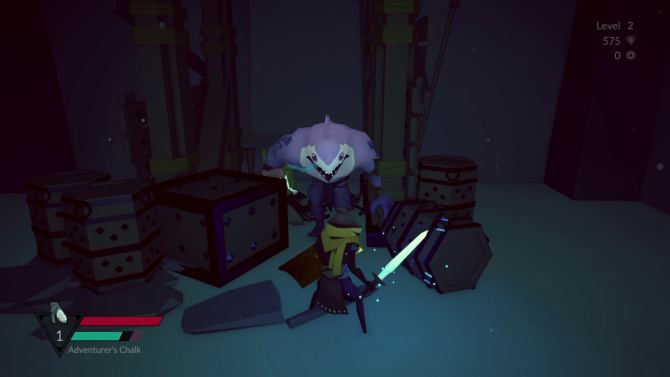Necropolis has the tough task of balancing the harsh punishment of resetting upon death with the enjoyment of progression due to its status as a rogue-like game. Upon death you lose nearly everything that was gained. The mystery of what enemies, traps, and equipment lie just beyond reach plays a major part in pushing you forward.
While this desire to move forward is strong thanks to the combat and humor, the punishment of death can at times be harsh. Due to the forced restart upon death, you will see a lot of the starting levels, repeats of enemies, and elements of the procedural world. While I hoped to see more and more of Necropolis, the way combat unfolds does not combine well with the desire to speed past an opening area that I have seen time and time again.
Developed by Harebrained Schemes, Necropolis debuted in 2015, came to PC earlier that year in July, and has now come to Xbox One and PlayStation 4. As a third person action role-playing game with rogue-like elements and a combat system that requires slow and methodical movement, it has been compared very often to Dark Souls. And while that comparison does have some merit, Necropolis is much more a rogue-like. Death causes a near-complete reset of the entire game, going so far as to send you back to the main menu screen to start a new game seemingly from scratch.
You are free to jump in with friends and only friends, as Necropolis supports four player drop-in, drop-out cooperative play. The only restriction is that you cannot matchmake with random people online, and instead have to rely on those you know who also have copies of the game.
Before you even begin you are given the option to choose from two character classes: the brute and the warrior. The brute has a larger character model, increased health and stamina, and is slower to move and attack. A small, but interesting characteristic is their ability to destroy pots simply by walking into them. Whereas the warrior must attack or dodge to break them. While not significant, it is worth pointing out since one of the objectives given to you by the "god" Brazen Head character is to destroy a certain amount of pottery scattered about. The warrior is more slender, fast, and has less health and stamina comparatively.
No matter which class you choose, everyone will start with the same sword and shield. Players also have the ability to purchase, or more likely, pick up better equipment on the field from fallen enemies and treasure chests. You can only carry two of each at a time and are free to swap between them with the tap of a D-pad button. You are not given very much detail as to the strength or advantages of different weapons, as no screen with stats can be accessed. Instead you are simply told what tier of weapon it is, and you have to learn the differences between weapons so you know what to keep on your next run.
Health doesn't regenerate and, while stamina does, it can be reduced temporarily by status effects or by utilizing a special attack by holding down either the light or heavy attack button. This will cause a more damaging offensive move to be performed, but also takes off a chunk of your usable stamina. Upon consuming a regenerative item, however, you will regain that stamina. Both your health and stamina can be increased permanently by offering the required amount of gems at the bookends of each level of the dungeon.
Crafting plays a role, and you start out each run in Necropolis with four recipes already known: rotten food, standard ration, chalk, and a potion that repels enemies or offers another boost. While new recipes can be purchased at specific vendors you encounter, none are carried over into your next run, which I did not enjoy. While I understand my items, weapons, and monetary funds can't carry over after death, codexes, which are unlocked via special tokens, do. I would have preferred if recipes were similarly unlocked via the tokens just so that I could access them post-death.
Potions and scrolls you find in the world may be clear in what it does, but more often they hold unkown effects, and may even contain a negative status that temporarily affects your sight, paralyze you, or poison you. Due to the randomized nature of these mystery potions and scrolls, you don't want to use them mid-battle, especially because the animation for activating it leaves you susceptible to damage. Instead it is best to use one just before you enter the eye-sight of a group of enemies, in order to know whether you need to wait out whatever effect was given or charge in while temporarily boosted.
Humor is not something I was expecting to encounter a lot of throughout the dark hallways of Necropolis, but even in the text from the aforementioned Brazen Head you will encounter a few laughs. A large majority of this is made up of usurping your expectations when it comes to flavor text that is generally used to build a game world's lore.
In Necropolis both dialogue from the Brazen Head and text you will find scrawled on walls throughout will be made up of about 90% general fantasy description. That last 10% though will be made up of something much different, usually a mocking or self-aware statement. This humor works because of how new and refreshing it is, but even then it can only last for so long before you start encountering repeats. Still is is charming when you read a line of dialogue that acknowledges the poor rhyming word choice of orange.
As a rogue-like you will be playing the opening section of Necropolis multiple times. Weapons, items, crafting recipes, and your funds will be wiped clean after death, and the world will be reset. Since it is procedurally generated, certain elements of the world will become familiar, though their arrangement will not.
The same can be said for enemies. As you progress further down the levels enemies you encountered previously will adopt new colors and visual effects to differentiate themselves from previous versions as the more difficult version of that model. While this is disappointing compared to the prospect of fighting only entirely new enemies, you do get a smattering of those as well with each descending level. You still find some of the same enemy models in the lowest level that you saw on the first, but while the appearance is very similar their behavior and capability is modified.
Combat requires a slow, methodical approach. Rushing into a crowd of skeletons and blindly swinging your sword will only earn you a quick death. Utilizing the lock-on is required, and knowing when to strike (usually after an enemy does) is key to killing opponents with a minimal knock to your own health. It is mostly this type of combat, as well as the focus on managing the amount of stamina you have at any given time, that has earned the comparison of Necropolis to Dark Souls. However, while in Dark Souls you had a slow pace to encounters and tough opponents, you at least had checkpoints that wouldn't set you too far back should you fail. In Necropolis, you die, and you begin again from the starting menu.
In other, faster paced rogue-likes this would be fine, especially when a shortcut is given to reach lower levels more quickly. Here you are instead forced to repeat the same opening progression upon each and every death, which are accompanied by somewhat mocking text from the Brazen Head. Its discouraging, and the inability to effectively speed past this repetitive section is frustrating. Sometimes there are holes in the ground, leading to a quick way to drop into the next level, but nothing that is reliable due to the procedural nature of the game. Thankfully if you fail to judge well and fall into the abyss the game merely resets you instead of killing you.
During certain actions, and not even those that contain multiple moving enemies on-screen at once, the framerate will seize up a bit. Its hard to explain, but basically the action will stop for a frame, and then a little later will skip to catch up to where I am now. This happened in both offline and online modes, although Necropolis doesn't really distinguish between the two as you can never completely pause the action. It's a strange technical issue that occurred often enough to become annoying in an otherwise well performing game.
Visuals are simple, with non-complex character designs that keeps things distinct from each other. Dungeons are dark, lighted by blue fire or varying colors of crystals. The score is mostly background noise, and no voice acting is found, though that isn't a negative aspect.
Reaching the ending isn't the true goal of Necropolis, although it is something you aim for. Instead the goal is more about finding everything there is to collect, from filling out the codex and dye collection, to learning for yourself which weapon and shield's are the best. There is satisfaction from slowly building your character up from almost nothing into a nigh-unstoppable warrior. That is, until you die. Certain choices made regarding what you carry over after a demise, as well as no clear and reliable way to skip introductory levels once you have completed them multiple times, kept me from jumping back in after a particularly long and successful run ruined by a dumb mistake.

